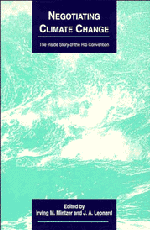Book contents
- Frontmatter
- Contents
- Acknowledgements
- Commonly Used Acronyms
- Foreword
- Part I Background
- Part II Views from Within the Ring
- 3 Exercising Common but Differentiated Responsibility
- 4 The Beginnings of an International Climate Law
- 5 Constructive Damage to the Status Quo
- 6 The Climate Change Negotiations
- 7 A Personal Assessment
- 8 The Road to Rio
- 9 A Failure of Presidential Leadership
- 10 Looking Back to See Forward
- Part III The Outside Edges In
- Part IV Prospects for the Future
- Appendix: The Framework Convention on Climate Change
- Index
10 - Looking Back to See Forward
Published online by Cambridge University Press: 01 June 2011
- Frontmatter
- Contents
- Acknowledgements
- Commonly Used Acronyms
- Foreword
- Part I Background
- Part II Views from Within the Ring
- 3 Exercising Common but Differentiated Responsibility
- 4 The Beginnings of an International Climate Law
- 5 Constructive Damage to the Status Quo
- 6 The Climate Change Negotiations
- 7 A Personal Assessment
- 8 The Road to Rio
- 9 A Failure of Presidential Leadership
- 10 Looking Back to See Forward
- Part III The Outside Edges In
- Part IV Prospects for the Future
- Appendix: The Framework Convention on Climate Change
- Index
Summary
Prologue: Why Revisit the Negotiations?
In any negotiation, the parties often begin with fundamentally different perspectives and with very different objectives. The final agreement represents an acceptable middle point between the “best case” expectations that each party held at the starting point of the talks. It is somewhat useful to revisit the negotiating procedure after an agreement has been concluded because without doing so one may miss some lessons that suggest how the subsequent process should move forward. Such an exercise, however, carries with it the risk of dwelling too much on what the various sides have gained or lost at a time when it is the common future vision which must be stressed. In this context there are three specific reasons for reviewing the history of the recently completed negotiations of the Climate Convention. First, it is useful to understand the final text of the agreement and the process that led to it. Second, it is important to learn lessons for future international negotiations. And third, it is possible to gain insights on how the agreed instrument should be implemented in order to achieve its objectives.
While the first reason would merit a review by itself, in my experience the final text of international negotiations include such minutiae that only law professors and candidates for legal doctorates take the trouble to interpret them.
- Type
- Chapter
- Information
- Negotiating Climate ChangeThe Inside Story of the Rio Convention, pp. 201 - 226Publisher: Cambridge University PressPrint publication year: 1994
- 4
- Cited by



